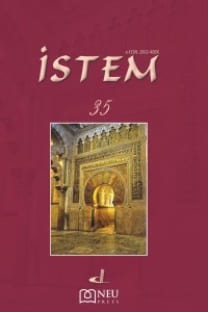ENDÜLÜS SANATLARI
İslâm idare merkezinden oldukça uzakta ve daima Hıristiyan kimliğini muhafaza eden bir yarımadada sıkışıp kalmış İspanya İslâm toplumunun patronları ve sanatçıları, İslâmî kültürel bir kimlik oluşturup bu kimliği savunmak için sanat ve mimariye şiddetle bel bağlayacaktı. Bu yedi yüzyılda (2./8. yüzyıldan 9./15. yüzyıla kadar) ortaya çıkan birçok üslubun ardındaki biçimsel yapılar ve bilinçli anlamlar alabildiğine farklı olsa da Endülüs sanatları, hem İslam merkezleriyle bağlantıyı koparmamak ve hem de mütecaviz yabancı bir kültürün ve dinin varlığına direnme adına etkili biçimler oluşturma ihtiyacı gibi aynı gizli gerilimle bir araya getirilmiştir. Elhamra Hükümdarlık Sarayı ve Kurtuba Ulu Camii… Her iki yapı muhtelif tarihi dönemleri temsil eder, fakat aynı zamanda Endülüs’teki sanat ve mimarinin sürekliliğinin ne olduğunu bize hatırlatır: kültürel bir kimlik yaratma ve onu koruma gerekliliği; varlığın idraki ve ötekinin mecbur bırakılması
Anahtar Kelimeler:
Sanat, Endülüs, el-Hamra Sarayı, Kurtuba Ulu Camii
The Andalusian Arts
Far from the centre of Islamic rule and embedded in a peninsula which would always retain a Christian hegemony as well, the patrons and artists of Spanish Islamic society would rely heavily on art and architecture to create and reassert an Islamic cultural identity. Though the formal structures and conscious meanings behind many styles emerging in those seven centuries (from the 2nd/8th to the 9th/15th century) are wildly different, the arts of Andalusia are strung together by the same underlying tension: the need to create forceful forms both to forge a link with Islamic centres and to defy the presence of an encroaching alien culture and religion. The Royal Palace of al-Alhamra and the Great Mosque of Cordoba… The two monuments certainly represent divergent historical moments, but they also remind us of what is constant in the arts and achitecture of Andalusia: a need to create and retain a cultural identity; a consciousness of the presence and force of the other
Keywords:
Arts, Andalusia, Royal Palace of al-Hamra, Great Mosque of Cordoba,
___
- Kaynaklar: Kaynaklar: Kaynaklar:
- » BASSET, H. – H. TERRASSE, Santuaires et Forteresses Almohades, Paris 1932.
- » BECKWITH, J., Caskets from Cordoba, London 1960.
- » BORRAS, G., El Islam: de Cordoba al Mudéjar, Madrid 1990.
- » CRESWELL, K. A. C., Early Muslim Architecture, II, Oxford 1932-40 (2. Baskı 1969).
- » EWERT, C., Spanish-Islamische Systeme sich kreuzender Bogen, I, Berlin 1968.
- » __________, Forschungen zur almohadischen Moschee. 1. Vorstufen, 2. Die Moschee von Tinmal (Marokko), Madrid 1981, 1984.
- » EXPOSITO, M., J. Pano and M. Sepulveda, La Aljaferia de Zaragoza, Saragossa 1986 (2. Baskı 1988).
- » FERNANDEZ PUERTAS, A., La fachada del palacio de Comares, Granada 1980. ———— 10
- Grabar, The Alhambra, s, 140-141.
- Terimin aynı zamanda Hristiyan kültürünün etkisi hususundaki tahlilli bir çalışma için bkz. J.
- Dodds, “ Paintings from the Sala de Justicia de la Alhambra: Iconography and Iconology”, The Art
- Bulletin, 16/2, 1979, s. 186-198.
- » FERRANDIS, J., Marfiles arabes de occidente, 1-2, Madrid 1935, 1940.
- » GOLVIN, L., Essai sur l’architecture religieuse musulmaneEssai sur l’architecture religieuse musulmane, vol. 4: L’art hispano-musulman, Paris 1979.
- » GOMEZ-MORENO, M., Arte arabe espanol hasta los almohades. Arte mozarabe, vol. III of Ars Hispanie, Madrid 1951.
- » GRABAR, Oleg, The Formation of Islamic Art, New Haven 1973.
- » __________,The Alhambra, Cambridge 1978.
- » HERNANDEZ, F., Madinat al-Zahra, arquitectura y decoracion, Granada 1985.
- » INSTITUTO VELAZQUES (Madrid), La casa hispano-musulmana. Aportacioes de la arqueologia, Granada 1990.
- » JIMENEZ MARTIN, A. – A. ALMAGRO GROBEA, La Giralda, Madrid, Banco Arabe Espanol 1985.
- » MARÇAIS, G., L’architecture musulmane d’Occident, Paris 1954.
- » PAVON, B., El arte hispanomusulman en su decoracion geométrica, Madrid 1975.
- » __________, Estudios sobre la Alhambra; Granada 1975, 1977, 2 cilt.
- » TERRASSE, H., L’art hispano-mauresque des origines au XIIIe siécle, Paris 1932.
- » TORRES BALBAS, L., Arte almohade. Arte nazari. Arte mudéjar, vol. IV of Ars Hispaniae, Madrid 1949.
- » __________, Artes almoravide y almohade, Madrid 1955.
- ISSN: 1304-0618
- Yayın Aralığı: Yılda 2 Sayı
- Başlangıç: 2003
- Yayıncı: N.E.Ü.İlahiyat Fakültesi İslam Tarihi ve Sanatları Bölümü
Sayıdaki Diğer Makaleler
ENDÜLÜS’TE REİS EBÛ OSMAN SAÎD B. HAKEM’İN MENÛRKA ADASI VALİLİĞİ
İSPANYA’DA GAYR-I MÜSLİMLERİN ENDÜLÜS İSLÂM KÜLTÜRÜNE KATKILARI
á. González PALENCIA, M. Faruk TOPRAK
ANA HATLARIYLA XI. YÜZYILDA ENDÜLÜS’TE SOSYAL HAYAT
ENDÜLÜS’TE COĞRAFYA VE COĞRAFYACILAR
İBN SİNA FELSEFESİNDE MEŞRİKÎ VE MAĞRİBÎ AYIRIMI ÜZERİNE BİR DEĞERLENDİRME
İBN SEB’ÎN VE HAKKINDA YAPILAN ÇALIŞMALAR
ENDÜLÜS İSTİDANAMESİ VE KEMAL REİS’İN İSPANYA SEFERİ
